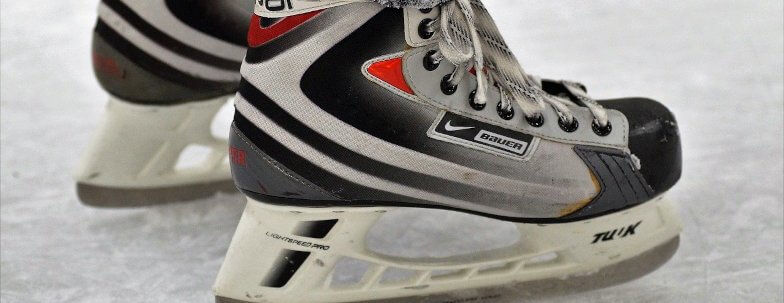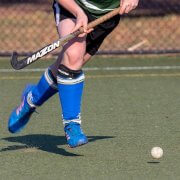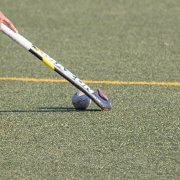How Do You Know If Your Ice Skates Are Too Small? Here’s How

Skates Too Small?
It seems like hockey skates have a reputation for being very uncomfortable, but much of this discomfort comes from the fit, not the skates themselves. Hockey skates that do not fit correctly can negatively impact your performance on the ice, not to mention the pain that you can experience from a hockey skate that is too small.
Your ice hockey skates are likely too small if they:
- Produce persistent discomfort, even after several uses
- Make your feet cramp during practice
- Are giving you an excessive amount of blisters
- Feel like they are “pinching” your feet
- Are not more comfortable after making adjustments
It is really easy to have trouble figuring out what ice hockey skate is the best for you. There are so many aspects that affect the fit of a hockey skate, and if you fail to account for each element, you are likely to have an uncomfortable experience with your skates.
We’ll discuss more in detail about how to tell when your ice skates are too small, how to fit a skate properly, and the different types of fits there are.
Signs Your Hockey Skates Are Too Small
Any ice hockey player can tell you that the skates are crucial to performance. Skates that fit correctly will optimize a player’s ability to skate fast, move with precision, and have no discomfort. Skates that do not fit properly result in slower play, less mobility, and increased pain or discomfort.
Hockey skates are meant to provide support to all areas of the foot and the ankle, and if even one of the areas is not correctly fitted, you can experience pain. For hockey skates, this may mean that your skates are too small even when you have the right size if the rest of the boot construction does not fit correctly.
Persistent Discomfort
When you first get hockey skates, it is normal to have some soreness until the skates are appropriately broken in. The new hockey skate will be stiff until you have played enough for the skate to mold to your foot.
This discomfort should only last for a few skates on the ice. If you have skated in your new hockey skates more than five times and are still dealing with blisters or pain, something is off with the fit of your skates.
Hockey skates that are too small may fit on one part of your foot but not another, such as fitting your foot’s length but being too small for your foot’s width. A hockey skate that is too small can cause discomfort in your foot or ankle, which should indicate that you may need to make a size change.
Foot Cramping
One significant sign that ice hockey skates are too small is foot cramping while skating. Naturally, the muscles in your body will frequently be sore and even overtired from playing hockey, but this should not be felt in your feet.
If your feet constantly cramp up inside your hockey skates, you are not getting enough blood flow to your feet. Without proper blood flow during activity, muscles cannot recover correctly. This causes painful cramps that make it very difficult to keep skating.
Blisters and Pinching
As with general discomfort of hockey skates, some blistering may be expected when you are just starting to break in your skates. This blister should not happen every single time you lace up your skates and play.
Similarly, you should not feel as if your hockey skates are pinching any areas of your feet or ankles. A properly sized hockey skate will be snug enough to provide support without any pinching.
If you are experiencing blisters or pinching when you wear your hockey skates, pay attention to where the discomfort is. Noting where the blisters are can be an indicator of what part of the hockey skate is too small as it shows where there is friction.
Areas that are pinched by your hockey skates receive too much pressure, which likely means that this specific area of the skate is too small. For instance, if you feel like the sides of your feet are pinched by the hockey skates, your skates may be too narrow for your feet.
Adjustments Are Not Helping
Before you completely give up on your hockey skates after just a couple instances of bad experiences, you should try making adjustments. Consider the type of socks that you wear and how tightly you lace up your skates.
Try skating with a different type of socks or with your hockey skates laced differently. If none of these minor adjustments relieve the pain, then your skates probably are too small for you to make do with.
You can tell that your hockey skates are indeed too small when you make adjustments, and they do not help. This indicates that some aspect of the hockey skate is not right for your foot.
How Do You Fit Hockey Skates?
Great, you have determined that your hockey skates are too small. Now what?
Fitting hockey skates is much more complicated than fitting regular shoes where most of the time, you only need to deal with the size and maybe the width of a standard shoe. With hockey skates, you have to account for the:
- Width of the skate
- Depth of the skate
- The volume of the interior
- The overall size of the skate
Each of these aspects must be correct in order for a hockey skate to actually fit properly. A hockey skate that is the right size but too narrow is, in fact, too small. That is why you must take the time to determine each part of a hockey skate’s fit.
Note: It is best and easiest to determine the fit of a hockey skate in person rather than ordering online. It is also best practice to work with hockey skate fitters to make sure you are picking the right pair of skates for your needs.
General Size
As a common rule of thumb, the size of your hockey skates will usually be one to two times smaller than your standard shoe size. That means that if you typically wear a men’s size 10 in shoes, you will probably wear between and 8 and 9 in your hockey skates.
It is essential to recognize that you may wear a different hockey skate size in one brand than in another. Different skate brands often have slightly (or significantly) different fits, so you should not assume that your specifications will be the same across the board.
Whenever you try on hockey skates, you should wear the type of socks that you usually wear for skating. This helps to ensure that you pick the right size for your foot and the socks. Essentially, do not try on hockey skates with really thick socks when you only ever play in thin socks. Wearing the wrong socks for a fitting makes the resulting fit inaccurate.
Hockey Skate Width & Width Ratio
Often the reason a hockey skate is too small is that the skate is not wide enough for the player’s foot. This is a frequent cause of pinching and foot cramps because there simply is not enough room for the width of the foot. This causes too much pressure to apply to the sides of the foot.
When we talk about width for a hockey skate, we are referring to the width of the forefoot. The forefoot is the widest area of your foot, so this is where you should measure to find the width. The forefoot is essentially the “ball” of your foot.
You then take the measurement of your foot’s length and divide that by the measurement of your foot’s width. This tells you the width ratio of your foot. The width ratio gives you an idea of what style of hockey skate will fit you best.
A wider foot will have a smaller width ratio, and a narrower foot will have a larger width ratio.
Depth of a Hockey Skate
The depth of a hockey skate refers to the heel area of the skate. Heel depth is determined by how high of an arch your foot has. A player with a very high arch to the foot will want to have a skate with a deep heel.
When you wear a hockey skate, your heel should not move around, so you have to make sure that the area of the skate is deep enough to “lock” your heel into the skate. Hockey skates offer heel depths in deep, standard, or narrow options. You should choose the depth option that provides the correct amount of support to your foot’s arch.
Volume of a Hockey Skate
The volume of a hockey skate refers to the dimensions of the skate’s boot. It also relates to the overall width of the foot. For instance, wider feet require hockey skates with a higher volume, whereas narrow feet require skates with lower volume.
Hockey skates come in a variety of designs to allow for players to find the type of skates that they need. Hockey skates come in a range of low to high volume designs, so do not settle for the wrong volume of skate just because it is a popular brand or style.
Hockey Skate Sizes by Ratio
Once you know the size of your foot in both length and width regards, you can determine what general fit of hockey skates is right for you. Choosing the right style of fit will help to make sure that you do not end up wearing hockey skates that are too small for you.
Traditional Fit
Hockey players with a width ratio of 2.5 or less should typically find the best fit in a traditional skate style. Hockey skates of this style are often referred to as having a traditional, classic, or comfort fit.
Hockey skates that have a traditional fit work well for players who:
- Have a wide forefoot
- Have a high arch
- Need a skate with higher volume
Hockey players with wide feet will usually opt for hockey skates that have a traditional fit because they have a wider design.
Contoured Fit
Contoured hockey skates are best for players with a width ratio between 2.5 and 3. This style is kind of like your average shoe.
Hockey Skates that have a contoured fit work well for players who:
- Have a standard-sized forefoot
- Have a standard heel depth
- Need a smaller volume than a traditional fit
Hockey skates of this kind are frequently called anatomical skates because their contoured shape allows for greater support of the ankle.
Tapered Fit
Tapered hockey skates are best for players who have very narrow feet. This style of hockey skate is often called the narrow fit for that very reason. Players who have a width ratio of 3 or higher should opt for a tapered fit.
Tapered fit hockey skates are best for players who:
- Have a narrow forefoot
- Have a shallow heel
- Need the lowest volume skate
Tapered hockey skates are considered to be low volume. Hockey skates of this style often maximize a player’s ability to skate at high speeds.
Testing Skate Fit
Naturally, measurements are the best starting point for determining if your hockey skates fit. That being said, people have unique feet that sometimes require a more individual fit. You should always take the time to test whether or not your hockey skates actually fit, regardless of how accurate your measurements are.
Sometimes, the best way to tell if your hockey skates fit is to play in them for a little while to see if they have the right feel. Every hockey player has a particular preference for how the hockey skates should feel.
Also, be sure that you have hockey skates that actually suit your purpose on the ice. A goalie has completely different needs from hockey skates than an offensive forward. Choose the right kind of hockey skate for your position so you can optimize your performance.
Toe Space Test
The very front of your hockey skate’s boot is the toe cap. Using the toe cap test is one of the best ways to tell if your hockey skates are the right size. Lace-up your hockey skates and then stand up straight. In this stance, your toes should lightly brush up against the toe cap.
Then, shift to a hockey stance with your knees slightly bent. In this position, your heel will sink deeper into the skate’s boot and “lock” into place. When you are in this stance, your toes should no longer be touching the toe cap.
You can often determine that your hockey skates are too small if your toes always touch the toe cap. There should be space when you are in a hockey stance, and if there is no space, then your hockey skates are too small for your foot’s length.
Finger test
To determine whether or not a hockey skate fits your ankle, you can use the finger test. You will need to lace your hockey skates up to the tightness they would be if you were playing. As in the toe space test, stand in a hockey position with slightly bent knees.
Reach back to the ankle and heel area of the hockey skates. You should not be able to fit more than one finger between your heel and the skate. If you can put more than one finger in this space, then your ankle and heel are not supported by the skate.
Youth players can have a space the size of one finger without much of a problem since they are still growing. Adult players can opt for hockey skates that have a snugger fit in the ankle area. The goal is always to make sure that the ankle is supported by the hockey skates.
Final Thoughts
Ultimately, hockey skates that do not fit correctly can be very painful and detrimental to your performance on the ice. Hockey skates that are too small can cause blisters, pinching, and overall discomfort.
One of the best ways to tell if your hockey skates are too small is by seeing if your toes still touch the toe cap when you are in a hockey stance. You can also test the fit of your hockey skates in your ankle area by seeing how many fingers you can fit between your heel and the skate.
When you are trying to figure out what size you need for your hockey skates, you must remember that your size depends on more than just the length of your foot. Many more things influence having a proper fit, including the:
- Width
- Width ratio
- Volume
- Depth
To ensure the best fit of your hockey skates, you should choose skates with the right fit for the size of your foot. Consider consulting with a hockey skate fitter to make sure that you pick skates that fit your feet perfectly.
Sources:
http://newtohockey.com/hockey-skate-fitting-guide/
https://www.hockeymonkey.com/learn/hockey-skate-sizing-buying-guide#
https://primaryice.com/how-to-choose-and-fit-hockey-skates-complete-guide/
https://protips.dickssportinggoods.com/sports-and-activities/winter-sports/find-your-fit-how-to-buy-the-right-hockey-skates




